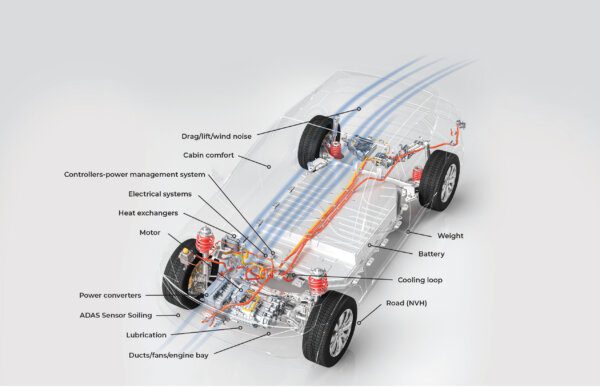Every vehicle operates in a constant state of flux. Not only must a car’s engine produce the necessary energy to propel the vehicle forward; its battery must also provide power to operate various electronic devices (sensors, radio, touch-screens, etc.) within the vehicle. These components, in turn, operate at different frequencies requiring constant DC to AC conversion. Electronic components must also withstand incredible temperature variation within a vehicle’s interior, from subfreezing to well over 100 degrees Fahrenheit.

Many of these challenges involve multiple physics–for instance, sensor systems must transmit and receive data within challenging, fluctuating environments; heat transfer can impede the optimal operation of electric motors and vital battery components. Multiphysics simulation makes it possible to account for such phenomena in designs and can provide design engineers with the tools needed for developing products more effectively and optimizing device performance.
Major Applications of Simulation in Automotive Design
Battery Cooling (BTMS)
A primary focus of new HEV and BEV design is the battery and its plethora of responsibilities. The battery demands of electric vehicles are magnitudes higher than in traditional vehicles, and maintaining the battery’s optimal functionality is paramount. Batteries undergo significant demand and can generate unwanted thermal energy, particularly during periods of fast charging or when power is being shuttled between the battery and the electric motor. Battery Thermal Management Systems (BTMS) are needed to maintain the ideal operating temperature, typically below 104℉. These systems manage and help to dissipate the heat generated by the battery components using forced air or liquid coolant.
Simulation has numerous applications for battery and BTMS design, from modeling heat transfer using computational fluid dynamics (CFD), to simulating fast-charging scenarios, to investigating the fluid dynamics of various coolant liquids. The electrochemistry of battery components can also be simulated in order to predict and, ideally prevent, thermal runaway.
Motor Design
Electric vehicles require electric motors that must perform as well as combustion engines under driving conditions that aren’t always forgiving on electrical components. Just as with batteries, heat transfer is a major concern, and is something that can be readily assessed using simulation. Simulation can also be very useful in optimizing motor topology by allowing numerous configurations to be modeled and tested virtually, prior to physical prototyping. So too can material selection be assisted by simulation, allowing designers to take a long-range look at how different materials may perform over time and under varying conditions.
Regenerative Braking Systems
Traditional vehicle braking systems create large amounts of heat through friction, and that thermal energy is simply lost. But regenerative braking systems in HEVs and BEVs seek to capture kinetic energy before it’s lost as heat and convert it into electric energy to be fed back to the car’s battery. Regenerative braking systems work by sending the vehicle’s electric motor into reverse, causing it to run backwards and slow the car’s wheels. During braking, the backwards-running electric motor becomes a generator, recovering and sending energy to the battery, thus extending range.
While electric vehicles also have traditional braking systems in place as a fail-safe, regenerative braking is employed frequently during stop-and-go urban driving. Simulation can be very useful in assessing heat transfer issues that could cause inefficiencies in regenerative braking systems during high usage scenarios such as urban driving.
ADAS Sensors
Advanced Driver Assistance Systems (ADAS) are increasingly incorporated into vehicle design (not just HEVs and BEVs) due to the improved safety outcomes and convenience they offer drivers. They are, in effect, a collection of networked sensors that reduce human error–sensors that provide lane departure and blindspot warning, traffic signal recognition, and parking assistance, for example.
Designers can use simulation to conduct a structural thermal optical analysis (STOP analysis) on optical sensors to predict how they will behave under a range of sunlight conditions, thereby optimizing their design. Piezoelectric sensors, such as those found in parking assistance systems, can be modeled to ensure that physical obstacles are appropriately recognized. And anti-soiling systems, designed to clean sensors while in motion, can benefit from the inclusion of a simulated two-phase flow analysis to determine likely patterns of liquid deposition on important sensors.
Aerodynamics
BEVs in particular require the incorporation of multiple batteries within the vehicle build to maintain cabin comfort systems (heating/cooling, etc.) that would be powered, at least partially, by the internal combustion engine in a traditional or HEV car. The incorporation of so many batteries can change the cabin dynamics, affecting aerodynamic concerns like lift and drag. Simulation offers a unique way to thoroughly investigate the effects of multiple in-cabin batteries on a vehicle’s aerodynamics.
A Better Design Process
Ultimately, simulation gives automotive designers insight and control. Virtual prototyping of a sensor or system can speed the design process and often costs far less than physical prototyping. It can save frustration and redundancy by providing insights and answers that point designers in the optimal direction prior to prototyping. And, as discussed above, these insights aren’t limited to sensors. The range of vehicle systems that are now being modernized, altered and optimized in the HEV/BEV era will only continue to grow, and simulation offers tools to make the design of such systems as efficient as possible.
Kyle C. Koppenhoefer is President of AltaSim Technologies. He has extensive experience in a wide range of computational mechanics applied to the medical products, automotive, petrochemical and defense industries.